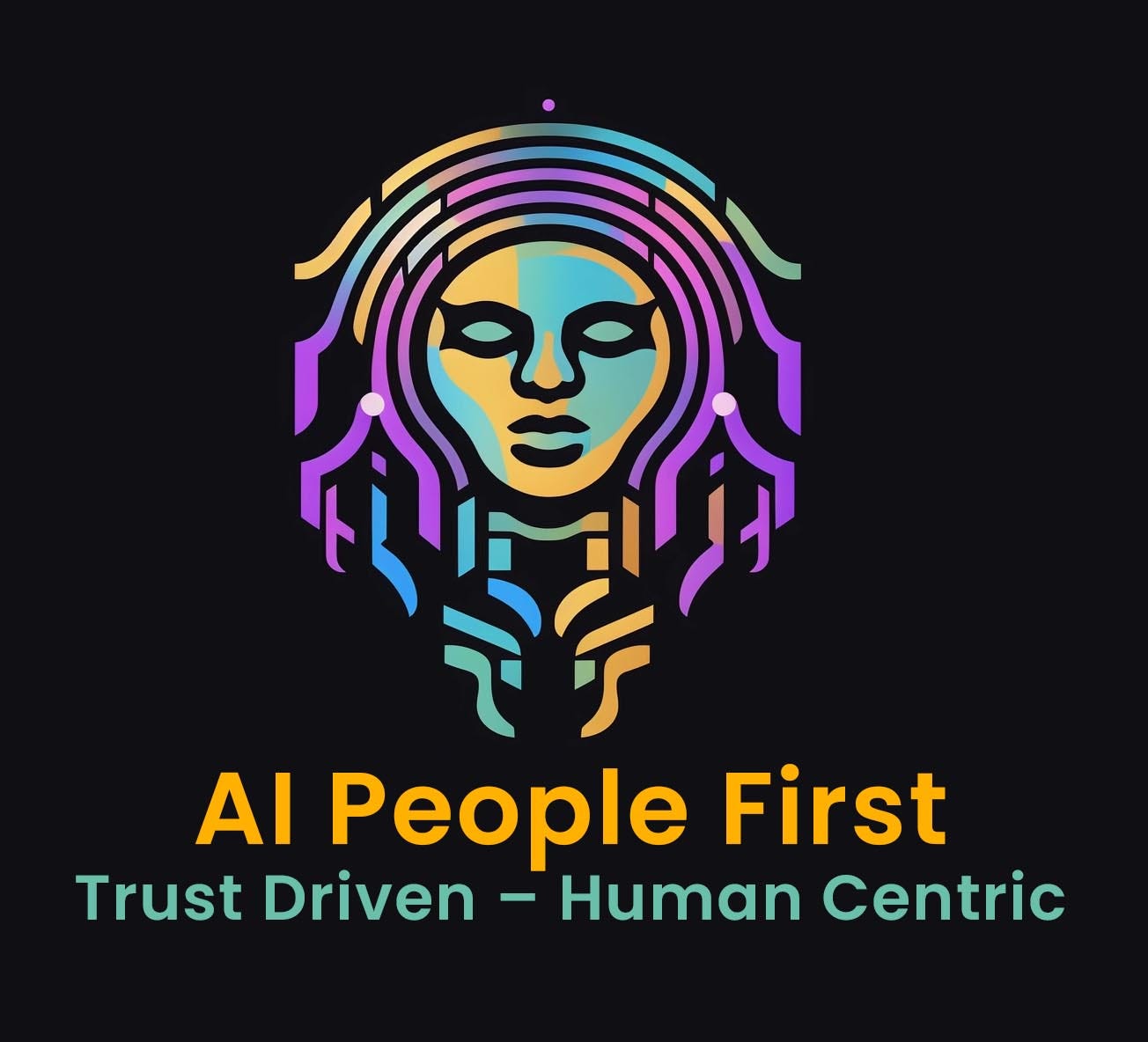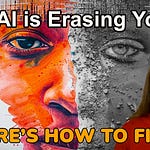Prehistoric cave paintings are vivid memories from some of humanity’s oldest art. AI is much the same, we’re once again mimicking reality, this time our brains, and afraid of what we find, and what it reveals.
AI People First is about appreciating and focusing on the human centric, trust driven AI which arises when we work with technology, rather than follow it.
00:00:00 AI People First Movement Intro
00:00:32 AI Needs Sociologists and Leaders not just Engineers - William A. Adams
00:03:37 AI can't replicate Children's Laughter with Jessica Mehring
00:04:44 Why People are the Answer to AI - The Question of AI Sentience
00:08:41 The Engineer's View of why AI will never be Sentient
00:17:48 AI First Technology Data Driven versus AI People First - Trust Driven and Human Centric
Listen on Apple || Spotify || YouTube
It's time we thought about how AI can serve us rather than how we can serve it. It's about making sure that AI enhances our lives.
Are you up for the challenge? We're calling this shift "AI People First," a unique venture to reshape the future of AI!
Benefits of the AI People-First Approach
The "AI People First" approach brings forth a bunch of benefits. By prioritizing humans above data, we can ensure that AI becomes a tool that genuinely serves us and affirms our needs, emotions, and aspirations.
This paradigm shift emphasizes ethics, transparency, and fairness in AI, significantly reducing the risks of algorithmic bias and discriminatory practices.
Moreover, it fosters a more inclusive environment for AI development by encouraging the participation of diverse groups.
Fundamentally, it guarantees that AI technology is developed with a clear focus on human values and societal well-being, resulting in AI systems that are not only highly effective and robust but also aligned with the interests of humanity.
Embrace the potential of AI that transcends mere intelligence, embodying wisdom, empathy, and a human-centric approach.
Let's harness the power of technology for our benefit!
Balancing Data-Driven Solutions with Human-Centric Perspectives
Of course, the power of AI lies in its data-driven nature and ability to analyze and learn from vast data sets far beyond human capacity.
No denying that. And we recognize the allure of focusing solely on the tech side – AI as an objective, a solution unto itself.
Yet AI's ultimate purpose is to serve humanity and improve our lives. If we let AI develop without considering its impact on people – on the vibrant code of our society – are we not missing the point?
Now many AI First companies are talking about ethics, safety and security, bias, and protecting us from negative impacts of AI. And that does matter!
Still the intention of their approach - focusing on AI First and often looking at human beings as replaceable, harkens back to the Industrial Age employment practices of making people cogs in a wheel.
So the solution to eliminate more people, cogs, with AI/robots/whatever plays into an old model that’s changing, and undermines what breakthroughs happen when you begin with people in mind, impacts, and design systems to maximize social impacts as well as business bottom line results.
The risk here is creating a powerful tool that begins to shape us rather than us shaping it.
"AI People First" doesn't mean disregarding the importance of data or the advances in technology. Instead, it's about achieving balance.
It's about using the power of AI while ensuring it aligns with our human values and societal needs. The real achievement in AI isn't in creating the most advanced technology but in using that technology to enhance human life.
So, let's join forces and shape an AI future that puts people first. An approach where we're not just data points in a machine's learning process but active participants steering the path of our technological future.
Yes, it's a challenge. But it's one worth undertaking for the sake of our humanity. And it's more efficient, secure, and trustworthy because it makes people stakeholders in this bright new AI future.
The Current AI-First Movement: A Brief Overview
The notion of an AI-first approach has garnered substantial interest in recent years. Companies place AI at the heart of their business decisions and conversations in an AI-first world.
Every facet of the business, from product features to employee roles, is scrutinized to see how AI can amplify data learning, predictive capabilities, and, ultimately, the company's competitive edge in the market.
The ethos of an AI-first company is perpetual growth, continual accumulation of unique data, and ceaseless improvement of their models. This allows them to learn and adapt rapidly, using data to gain a competitive edge.
But while the AI-first approach has its merits, it has its downsides. The emphasis on data and technology can overshadow the human element, often leading to decisions that prioritize efficiency and profit over human values.
This approach often overlooks the importance of human experience, creativity, ethics, and emotions - the intangible elements that make us human.
The AI-first approach is not wrong by focusing on business efficiency, but it needs to evolve to become more inclusive of the human impact. And by relying more on technology than people, the perspective skews into one trusting data-driven solutions which repeatedly create scary scenarios these same people warn us about.
You often find what you look for, and AI is no different - we’re looking for magical technology instead enhancing lives first.
That's where "AI People First" comes in, as a step forward from the current AI-first movement.
It's about integrating the human touch into the AI-dominated world, making it a lighthouse for humanity in the digital age.

AI People First: A Paradigm Shift Towards Security, Accessibility, and Trust
The AI People First approach is not just a human-oriented initiative; it's a catalyst for enhanced security, privacy, accessibility, and trust.
By instating human-centric checks and balances, we ensure that AI systems are not unduly influenced by biases in their training data, creating a more secure AI environment.
By focusing on privacy, we transform AI from a potential threat into an asset, placing control of personal data back into the hands of individuals.
This accessible approach to AI fosters an environment where everyone can benefit from the technology, not just those with a deep understanding of it.
AI People First's triumph lies in its ability to cultivate trust.
By demonstrating that AI exists to work with us, not against us, we can alleviate the fears of the public, employees, and even politicians.
The perception of AI shifts from being seen as a potential menace to being recognized as a beneficial tool that supports us in achieving our common goals.
This is the essence of the AI People First movement.
The Imperative of AI People First: Earning Our Place in the AI Narrative
So, why does AI People First matter? We stand at a crossroads in our technological story. As AI becomes more capable and learns and grows at unprecedented rates, we must decide whether we want to be passive observers or proactive shapers of this narrative.
Imagine a world where AI is not just an entity working in the background but is a tool that truly understands and respects human values.
A world where AI isn't a threat to our jobs but instead becomes our best collaborator, enhancing our skills and creativity.
A world where AI doesn't rule us but where we, the people, guide AI to help build a more equitable, inclusive, and compassionate society.
This is the promise of AI People First. It's not just about making AI smarter. It's about making AI work better for all of us.
It's about cherishing and preserving what makes us human even as we embark on this exciting journey of technological revolution.
This is our invitation to you – let's not just adapt to AI; let's shape it to adapt to us!
The traditional approach to AI has often emphasized what technology can do without considering how it can best serve humanity.
That's why the AI People First movement is gaining momentum, focusing on creating AI systems that are ethical, human-centric, accessible, transparent, accountable, and aligned with societal values.
Let’s explore the principles of AI People First, the benefits of this paradigm shift, and how it can impact businesses and society.
AI People First: A Safer, More Ethical Approach to Technology's Future
The principle of Ethical AI is the foundation of the AI People First movement. AI systems should respect human rights, privacy, and dignity and avoid reinforcing biases or discrimination.
While Followers of the AI-first approach do consider ethics, protection, safety, and security, these considerations often take a backseat to their primary focus on data-driven engineering.
To truly embed ethics and humanity at the core of AI, we must start with the end-users—the people it serves—before delving into the technology.
Glaring examples - like COMPAS's biased approach to criminal justice reform and Amazon's unsuccessful attempts to enhance diversity through AI - highlight the dangers of letting an emerging technology take control.
By prioritizing people, we inherently embrace these ethical standards. It's like the age-old saying, "garbage in, garbage out." People, not just data, should be the primary input. Benefiting them should be the targeted output!
Executing the AI People First Approach: Transforming Concept into Reality
This means that the development and use of AI should be guided by ethical standards and involve diverse perspectives from all stakeholders.
For instance, AI can improve healthcare outcomes but should not compromise patient privacy or medical ethics.
Similarly, AI can enhance education, but it should not lead to a digital divide between those who can access it and those who cannot.
Another fundamental principle of AI People First is Human-Centric Design.
AI systems should meet human needs, enhance rather than replace people, and be user-friendly. The aim is to improve the quality of life for individuals and communities rather than just maximizing profits or efficiency.
For instance, AI can personalize customer experiences, but it should not lead to a loss of human touch or empathy.
AI can also upskill the workforce but should not replace human creativity or intuition.
Accessibility is another critical principle of AI People First. AI technologies should be available to all, regardless of age, gender, ethnicity, or physical ability.
This involves ensuring that AI systems are inclusive and adaptable, with features like speech recognition, text-to-speech, and captioning. This can help bridge the digital divide and enable more people to benefit from AI rather than being excluded from it.
The Upskilling principle involves AI's transformative power to retrain and upskill the workforce. AI can create new jobs and opportunities and improve efficiency and competitiveness.
However, this should be done in a way that helps workers acquire the skills and knowledge needed to adapt to the changing job market. This can involve offering training programs, mentorship, and lifelong learning opportunities.
AI for Social Good is another critical principle of AI People First. This involves using AI to address societal challenges such as healthcare, education, and the environment.
For example, AI can improve early disease detection, predict natural disasters, or reduce energy consumption. This can positively impact people's lives rather than just serving the interests of a few.
Integrating AI Development with Human Values: The Key Principles to Follow
Emotional and Social Intelligence, Transparent and Accountable, and Stakeholder Engagement as the Cornerstones
Emotional and Social Intelligence involves developing AI systems to understand and respond to human emotions and social contexts.
Being transparent and Accountable means making AI algorithms transparent and explainable so people can understand how decisions are made and provide feedback.
Stakeholder Engagement involves ongoing dialogue with policymakers, technologists, and the public to ensure that AI development is aligned with societal goals and values.
Making AI People First a Reality: Start Today
The AI People First movement is about putting humanity at the center of AI development rather than just focusing on what technology can do.
By adopting the principles of Ethical AI, Human-Centric Design, Accessibility, Upskilling, AI for Social Good, Emotional and Social Intelligence, Transparency and Accountability, and Stakeholder Engagement, businesses, and society can benefit from AI in a way that is inclusive, sustainable, and aligned with human values.
As AI continues transforming the world, let's ensure it serves humanity, not vice versa. Join the AI People First movement and be a part of creating a better future for all.
Let's work together towards a brighter future where AI is used to enhance human potential and positively impact our world. Together, we can make the AI revolution truly people-centric. Let's make it happen.
Share a comment and we’ll let you know when this officially launches in January 2024!



















